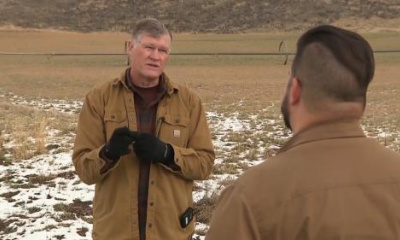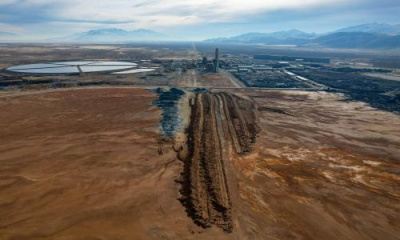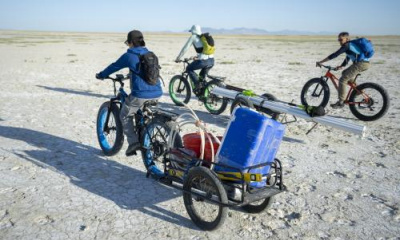SALT LAKE CITY — Motorized vehicles are banned from traveling on exposed lakebeds and navigable rivers in Utah, but a problem emerged in recent years with the way it's written in state law.
It wasn't completely clear to anyone what types of vehicles were and weren't allowed in those spaces, before this year's legislative session. That, in turn, made it difficult to enforce or prosecute.
"People are just under the impression that if there's no fence, there's no gate and there's no sign, that it's OK to just drive an ATV or a motorcycle or a passenger car or a truck on that land," said Jason Curry, the deputy director of the Utah Division of Forestry, Fire and State Lands.
However, a new adjustment to the law erases the ambiguity in how the law is interpreted, and Utah lawmakers and land managers hope the clarification will ultimately help protect residents from pollution unwittingly created by people who don't follow the law.
HB317 clarifies that motor vehicles include off-highway vehicles in addition to cars, trucks and motorcycles. In essence, it's illegal to drive any vehicle that has a motor on an exposed lakebed or navigable river.
While the bill impacts areas like Bear and Utah lakes, as well as the Bear, Colorado and Jordan rivers, the reason the change matters — and why Rep. Doug Owens, D-Millcreek, pushed for a minor tweak in the law — has everything to do with one exposed lakebed in particular: the Great Salt Lake.
The dust from the Great Salt Lake is especially problematic because it contains naturally occurring toxic heavy metals. It's naturally protected by a salt pan, but when that's disturbed — something a large vehicle can easily do — the dust below it becomes exposed.
When a powerful storm comes in, that dust is kicked up from the drying lake, where it can easily end up blowing into the approximately 2 million people living in communities all around the lake's eastern edge. It's even known to negatively affect the state's snowpack, which accounts for about 95% of the state's water supply.
"This was designed to make sure that the increasingly exposed lakebed doesn't get broken up," Owens said. "If you break that crust, then the underlying dust is more easily airborne. … It's a serious air quality issue, potentially."
Two colliding issues
The timing of the bill coincides with two major recent issues. The lake reached an all-time low last year and is projected to continue to shrink in the coming years, according to Utah State University's Utah Climate Center.
Molly Blakowski, a USU graduate student, says this means about half of the lake has turned into hazardous dust. How dangerous is this dust? It contains arsenic and human-made chemicals that ended up in the lake.
Since it's a terminal basin lake with no outflow, chemicals that flow in don't leave, except through evaporation. It's why the lake is salty and why chemicals then get absorbed into the sediments.
"What's unique about the Great Salt Lake and the dust that's being kicked up here, these sediments have been polluted urban, industrial and agricultural inputs for a very long time," added USU graduate Jeffrey Perala-Dewey.
A 2019 University of Utah study also found areas with higher silt and clay fractions are most prone to wind erosion. Owens points out that modern off-road vehicles can easily cause their fractions to the salt pan.
At the same time it's drying, state land managers are noticing more people traveling onto its empty land, cutting into the protective salt pan. There aren't exact numbers on land use, but anecdotally, they've noticed an increase in tire tracks on the dried lakebed since the rise in outdoor recreation after COVID-19 restrictions were introduced in March 2020.
"We did see a pretty big increase in recreation, but particularly in areas that are a little bit more off the beaten path, so areas around the Great Salt Lake … became more of a destination for people to really go beyond the social distancing," Curry said.
Despite the law, he believes the problem on the Great Salt Lake started from one person going out onto the lakebed, leading to other people seeing tracks and doing the same. Since there's there's a lot of land slowly becoming available, it's difficult to put enough signage to let people know they can't drive there.
It eventually spiraled out of control, as an increasing number of vehicles dug into the lakebed. One of the most egregious cases was someone drove their SUV out onto the Spiral Jetty, the state's official work of land art located by the lake's northeast edge.
Blakowski and Perala-Dewey are currently researching dust storms and their impacts on communities, but they are happening, bringing the chemicals from the lakebed with them.
"As anyone has looked out at the Great Salt Lake during these drought years … you can see those dust clouds from a long ways away," Curry said. "And they eventually end up impacting our air quality on the whole."
Adjusting an unfollowed law
That's where HB317 comes into play. It helps clarify that all motor vehicles aren't on the lakebed. A violation of the law is a class B misdemeanor, which is punishable by up to a $1,000 fine and even six months of jail time.
The updated law officially goes into effect on May 4, along with all the other bills signed this year.
While it does reduce options for riders, Owens contends there are "plenty of places" in Utah where people can use off-highway vehicles that won't create as large of air quality issues as with the Great Salt Lake. The bill even gained support from the state's off-highway vehicle community leaders.
Outdoor recreation groups Utah OHV Advocates, Utah Powersports Dealers and Utah Off-Roaders Alliance gave their blessing to the bill when it was introduced in February.
"It's time to take better care of our fragile lands, lakes (and) rivers, and I think this bill will definitely help," said Brett Stewart, the president of the Utah OHV Advocates, during a House committee meeting.
The state also opened up funds for more outreach, education, signs, new cameras and even a new law enforcement officer who will primarily ensure there aren't trespassers on the Great Salt Lake lakebed and other sovereign lands nearby. The new officer is expected to be hired by June.
Curry hopes the changes will send the message that people aren't allowed to drive on the dried parts of the Great Salt Lake.
"(We want to) make sure people are following the rules," he said, "and keeping the resources protected and available for everybody to enjoy in the future."
Contributing: Kira Hoffelmeyer, KSL NewsRadio









